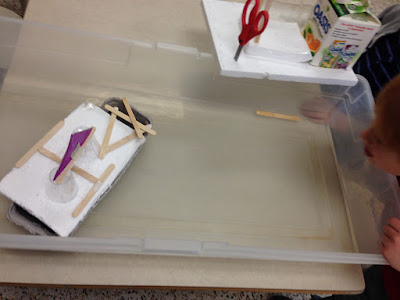by Stephanie Bartlett
A big part of my journey this year has been exploring documentation panels. Inspired by the many talented educators on twitter, I have read, thought, researched, reflected...and the cycle repeats. I take photos and videos and must admit that I am still figuring out a process to post the photos in the classroom in a timely manner. (I would appreciate any techniques from those well versed in the world of documentation panels.)
The other day, I printed the photos of our coconut explorations. I thought that if Hunter cut out the pictures, and we explained them together, then the panel would be meaningful to him rather than the parents coming for conferences as had been my original intention. He got some fine motor and sequencing practice cutting and ordering the pictures before we got ready to document the story.
I settled in with sticky notes and proceeded to be amazed at what I learned from Hunter. I thought he would label each event in each picture. Instead, Hunter labelled the steps of collaboration. The first step was Hunter finding the coconut and exploring on his own. The second group of pictures was when Erik came to join him, the third was the class (spelled phonetically KSE) and the fourth was the opening of the coconut.
Together we reflected on the different questions that he had been asking and I scribed those underneath. The message had come through loud and clear for me and I was thrilled: collaborative development is an integral part of creativity in educational practice. Hunter showed me in his own words that collaboration has been embedded in our classroom culture.
There is an important place for teacher-directed documentation panels to explain our programs to adults, and to celebrate the learning of our students by showing the thinking process. Dylan William states in his book Embedded Formative Assessment that "teachers have a crucial role to play in designing situations in which learning takes place, but only learners create learning." (William 158) I provided the learning provocation and then the pictures; Hunter responded with a high level of engagement and showed me how students can help manage their learning process. It is now up to me to take everything Hunter shared with me to help design new learning experiences for him and the class.
Citation:
William, Dylan (2011.) Embedded Formative Assessment. Bloomington, IN: Solution Tree Press








 The following summer, we provided the safety talks, some supervision and a daily inspection of the building site to tighten screws and reinforce structures. A real tree fort began to take shape. Towards our last day of that summer, the gang wanted to have a bonfire. The answer? Absolutely not and our reasons were many: the fort was in the middle of the forest, there was no water source to put out the fire, and kids weren’t allowed to build fires, to name a few. They disappeared into the woods without argument, only for us to be invited back at the end of the day. What we found amazed us. A fire in the middle of the woods? No problem. The kids had cleared a large spot to the point where there was not a single leaf. They had clipped any branches that were close and dug a fire pit, surrounded by rocks dug out from the forest floor. They had gone so far as to build benches, with cut and stacked firewood underneath, and even carved marshmallow sticks. And the no-water problem? That was addressed by the presence of a large garbage can, buckets and a plan. If they were allowed to have the fire, they would truck water up from the lake back to the tree fort to fill that bucket. And the icing on the cake was the railing they built to get up into the woods, knowing that one of the parents experienced severe knee pain. We were convinced.
The following summer, we provided the safety talks, some supervision and a daily inspection of the building site to tighten screws and reinforce structures. A real tree fort began to take shape. Towards our last day of that summer, the gang wanted to have a bonfire. The answer? Absolutely not and our reasons were many: the fort was in the middle of the forest, there was no water source to put out the fire, and kids weren’t allowed to build fires, to name a few. They disappeared into the woods without argument, only for us to be invited back at the end of the day. What we found amazed us. A fire in the middle of the woods? No problem. The kids had cleared a large spot to the point where there was not a single leaf. They had clipped any branches that were close and dug a fire pit, surrounded by rocks dug out from the forest floor. They had gone so far as to build benches, with cut and stacked firewood underneath, and even carved marshmallow sticks. And the no-water problem? That was addressed by the presence of a large garbage can, buckets and a plan. If they were allowed to have the fire, they would truck water up from the lake back to the tree fort to fill that bucket. And the icing on the cake was the railing they built to get up into the woods, knowing that one of the parents experienced severe knee pain. We were convinced.











 Erin Quinn
Erin Quinn








